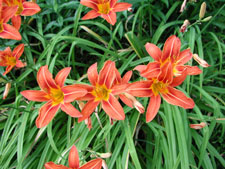Resource Library
Plant of the Week: Lily, Ditch
The University of Arkansas System Division of Agriculture does not promote, support or recommend plants featured in "Plant of the Week." Please consult your local Extension office for plants suitable for your region.
Plant of the Week
Ditch Lily
Latin: Hemerocallis fulva

Daylilies are common fare in gardens with modern kinds displaying an array of pastel shades in bi- and tri-color combinations, wavy margins and about every other imaginable variation. The modern daylily is an engineered plant and very different than the dozen or so species from which modern cultivars were produced. One of the parents of the modern daylily, Hemerocallis fulva, gets little respect and goes by such derogatory names as ditch lily, outhouse lily or officially, the tawny daylily.
The ditch lily is the vigorous orange-flowered deciduous daylily with typical inch-wide linear leaves that arise from a central clump and reach about 2 feet long. The flowers appear on a 3- to 4-foot tall scape held well above the foliage in June and July. Flowers are 5 inches across and orange with a yellow throat. Blooms open mid-morning and wither by the end of the day.
Daylilies were known to the early Roman, Greek, and Egyptian doctors from plants brought from China over the Silk Road about 2,000 years ago. Northern Europe only learned of them in the 16th century with Hemerocallis fulva introduced directly from China in 1576. It quickly gained favor in gardens and became widely planted.
The first recorded planting of the tawny daylily in the United States was in 1793. It became the ultimate pass-along plant and by the early 20th century was so commonly found in wild places it was often assumed to be native. Surprisingly the plant is sterile and almost never sets seed pods so its widespread distribution is the handiwork of gardeners.
In the 1930’s Dr. A. B. Stout began studying daylilies and unlocking the secrets of their reproduction. One of Stout’s most important discoveries was to explain that the common and vigorous ditch lily was a natural triploid with three sets of chromosomes. He gave it the cultivar name ‘Europa’ but in the Flora of China it is called H. fulva var. fulva. Because it is seedless, all of the millions of plants scattered around the world are clones.
Adding an extra set of chromosomes normally increases vigor. The mule, a cross between a horse and a donkey, is a common example. In the daylily world, breeders today work with “dips” (normal plants with 2 sets of chromosomes) or “tets” (plants with 4 sets of chromosomes). Crossing dips with tets can be done to produce a triploid but is difficult and is usually not desirable because it produces sterile progeny and is an abrupt end to a breeding line. Ditch lily apparently arose spontaneously and was propagated by some keen-eyed Chinese gardener.
There is another secret to the widespread success of this sterile plant. Most daylilies grow in well-defined clumps but H. fulva produces a foot long stolon (a modified stem) so plants scamper about the garden as they seek new places to run. Thus ditch lily is an aggressive competitor in the border where it is likely to crowd out more timid plants. But in waste places afflicted by inner-city blight this aggressiveness makes it desirable where it can even outwit weeds.
Few daylily specialists consider the lowly ditch lily a worthy addition to their collection but it may have a place as a groundcover plant in difficult locations where plants must fend for themselves. And for gardeners interested in growing heirloom plants it is a natural because it hasn’t changed in the past 400 years.
By: Gerald Klingaman, retired
Extension Horticulturist - Ornamentals
Extension News - July 10, 2009
The University of Arkansas System Division of Agriculture does not maintain lists of retail outlets where these plants can be purchased. Please check your local nursery or other retail outlets to ask about the availability of these plants for your growing area.